Rain gauge comparison
Productive Alternatives "Stratus"
vs. Outback Blue
Introduction
A couple years before I started writing this page, I looked into reporting the
snow/water equivalent (SWE) of snowfall by weighing it and converting its mass
in grams (that's what my scale liked to report) to inches of precip. It seemed
to work pretty well. Since my results generally had two significant figures,
e.g. 6" of snow is typically 0.60" SWE, I did my calculations with low
precision values for pi and cm/inch, and came up with the happy ratio that 200
grams of water in my gauge is close to 1" of rainfall.
Eventually I decided I should come up with a more accurate converstion
factor, and then trim the significant figures. I even made a spreadsheet, and
was a bit surprised that using 3.1416 for pi and 2.54 for cm/inch, and 2" for
the radius of the 4" funnel, πr²h; becomes 3.1416 × (2 ×
2.54)² × (1 × 2.54) = 205.926 cm³/in of rainfall. (1
cm³ is 1 milliliter (ml), a more common term.) I hadn't applied a factor
for the density of water, which is 1.00 at 3.98°C. At my typical room
temperature of about 20°C (68°F), water's density is 0.99823 g/ml.
It's currently summer, and room temperature is higher, about 25°C, and
water's density is 0.99707 g/ml. That's close to 1, but it does mean that
inch of rainfall is a measurably different 205.323 grams.
Note that it's easier to weigh rainfall than try to read it on the rain gauge.
From discussions on the CoCoRaHS FaceBook page, I'm convinced that a lot of
people aren't reading the meniscus "properly," i.e. read the bottom of the
meniscus. On days where there is more than one inch of rainfall in the gauge,
it's much quicker to weigh the gross weight (gauge and rain), and subtract the
weight of the gauge (tare weight) to get the weight of the rainfall (net
weight). It also reduces the risk of spills while transferring water from the
outer tube to inner tube.
I quickly discovered that using 205 or 206 for a conversion factor gave me rainfall
amounts that were more different than simply using the 200 factor! They gave me results
that were consistantly less than what I saw on the rain gauge.
I resolved to look into to this some day, but then got tied up with divorce, moving,
spending too much time on FaceBook, and having a job.
I needed better equipment too. My scale came from some surplus catalog that
was common before the WWW came along. I.e. it was was old. It also had 1
gram resolution. It was accurate to some 0.5%, but I needed a scale with 0.1 gram
resolution. I found a $12 scale with 0.01 gram resolution and 0.03 gram
accuracy. Amazing. I spent more money on calibration weights to see if the
scale was accurate - it is. I had an old digital caliper that had 0.001"
resolution, but it died one day, so I replaced it with one with 0.0005"
resolution.
To take full advantage of this level of accuracy requires much more care in
handling everything. It also allows answering questions that couldn't be
touched before, e.g. what is the impact of evaporation from within a rain
gauge?
Recently a new rain gauge appeared on the market from Australia, the Outback Blue
(OB) gauge. Superficially it is designed similarly to Productive Alternatives's
(PA) Stratus gauge that is the sole gauge used by CoCoRaHS. However, an early
criticism of the gauge was that it provides rainfall amounts consistantly
lower than the PA gauge. Okay, that doesn't answer my interest - "which gauge
is more accurate?" It does say it's time to order one and compare both to
what the design parameters are.
I had two old CoCoRaHS approved gauges, the Productive Alternatives
Stratus gauge, PA for short. I bought one before CoCoRaHS reached New Hampshire,
I won the other as a door prize at CoCoRaHS training in 2010. So I bought a third
to have a new gauge before it outgasses a lot of whatever it is that PA gauges smell of.
Dimensional stability over time can be important too.
Dimensions
Several attributes are very important to the accuracy of these gauges, and
they have to be verified to determine the overall accuracy:
Diameter of funnel opening
Everything the gauge catches passes the area of the cross section at the
top of the funnel. I.e. They both claim to be 4" diameter circles. It turns
out that when wind gives rain a horizontal velocity component, things
still work well - the rain drops "see" an elliptical cross section, but
they're moving faster, and the funnel catches the same number of rain
drops. Secondary effects come into play with splashing on the side of
the funnel and modified airflow, but for the most part a gauge that is
mounted vertically will work well.
The diameter of the inner tube.
The inner tube squeezes the rain into a smaller space so some amount of
rain needs more height to hold it. This makes it easier to read rain at
the high resolution we want.
The scale marking on the inner tube.
At some point we need a ruler, and the spacing of the marks depends on
the cross section of both funnel and inner tube.
The last two can be combined - all that's needed is that the scale accurately
marks the water volume in the inner tube.
Note that the diameter of the outer tube is immaterial, at least until you
take the funnel off to catch snowfall. I won't address snowfall here.
Here are some measurements of the PA and OB gauges. For the funnel and
outer tube, I measured near the top because that area is critical to getting
an accurate sample. I measured further in on the inner tubes as that is not
so critical and I can rest the caliper body on top of the tube. I will have
to revisit the OB tubes as both are conical, not cylindrical. It might be
worthwhile to verify the spacings of the marks on the OB inner tube.
| | Ideal | PA old | PA new | Outback
Blue |
|---|
| Funnel diameter | 4.000" | 3.981" | 3.986" | 3.991" |
|---|
| Funnel area (πr²) in cm² | 81.073 | 80.305 | 80.507 | 80.709 |
|---|
Volume of 1" of rain in ml
(ml = cm³) | 205.93 | 203.98 | 204.49 | 205.00 |
|---|
Mass at 25°C
(density 0.99707/cm³) | 204.49 | 203.38 | 203.89 | 204.40 |
|---|
Outer tube diameter
(at top) | 4.000" | 3.986" | 3.977" | 3.996" |
|---|
Inner tube diameter
(at top) | 1.265" | 1.260" | 1.260" | 1.360" |
|---|
Notes
Diameters were directly measured and are the average of two or three measurments.
I'm not completely happy with them, challenges included measuring an actual
diameter instead of slightly off, measuring near the top instead of what's
more convenient for the calipers, etc.
It didn't occur to me at first to adjust for water density.
Water has a density of 1.000 gram per ml at 3.98°C. In the section
below I used water from a two liter bottle that spent hours at room
temperature. It's tap water, but very clean tap water. Clean rain is
essentially distilled water with a little dissolved CO2 and some cloud
condensation nuclei. I couldn't find a measurement for its density on
Google, but it's got to be so close to pure water as to make the
exercise pointless.
Note that ignoring density implies a 0.3% error in measurements.
While that's barely visible when reading the scale on the inner tube, it is
important overall.
Note to self:
For version 2, consider density (maybe at 10°C), do everything in metric.
The OB tubes are slightly conical
For the inner tube, that presents some challenges in checking the scale
on the tube. For the outer tube, that is pretty much immaterial. It
might make snow core samples easier, or maybe harder. Not a concern
here.
Inner tube measurements
Instead of measuring the diameter of the tube and verifying the accuracy of
the scale, I'm taking the amount of water that equals 0.1" of rain into a 4"
funnel, then measuring ten of those and pouring them into the inner tube one
at a time. I had forgotten about density, so that's not included. From the
table above, we need 20.59 grams of water per 0.10" increment.
Measuring that amount of water is a bit of a challenge, as a water drop
from an eye dropper is typically 0.05 grams so it's not accurate to use. I
used this procedure:
Dispense 20.60 to 21.50 grams of water into a moderately hydrophobic polycarbonate
kitchen measuring cup.
Transfer the excess amount by repeatedly dipping a cotton swab in the
water and transferring it to a sponge until 20.59 ± 0.01 grams are left.
It's hard to get that last 0.01 gram right!
First time measurement: discard and redo.
This allows "preloading" the measuring cup with the small droplets of
water that remain between samples.
Subsequent measurements: zero the scale before each measurement.
This ensures each measurement will add the desired amount to the cup,
and ultimately that will be what's poured from the cup.
Pour the water into the inner tube along the side of the tube.
Water droplets will bead on the surface of the tube, but they will be
collected as the tube files. The first reading may appear a little low,
but note we're not in a high resolution arena.
Photograph the water level in the tube
Aim the camera horizontally on a tripod, frame the view to center on the
bottom of the meniscus.

Weigh station |
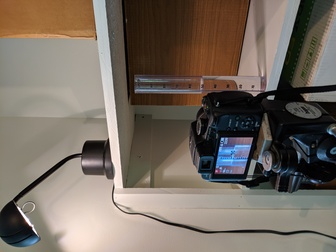
Photo station |
I had a problem with the PA tubes, as the 1.00" would have been higher than the drain slot in the tube. I covered the slots with a small piece of scotch tape.
While one can see water levels are between marks on the tubes, trying to make readings down to 0.001" is nearly futile. The main qualitative things to look for are:
These can be demonstrated photographically. The old Productive Alternatives tube is on the left, the Outback Blue tube is on the right. The new gauge is not included.
There is one quantitative issue, and is easy to read from the photographs.
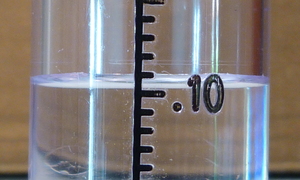
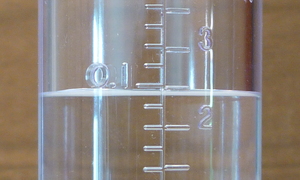
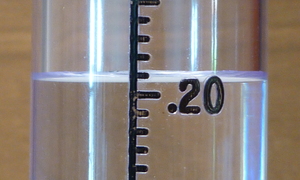
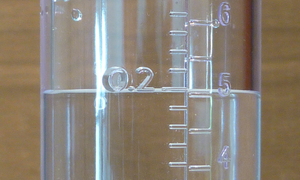
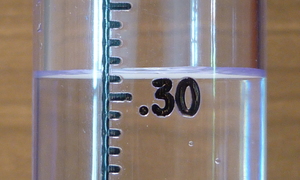
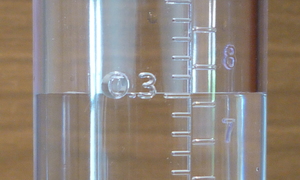

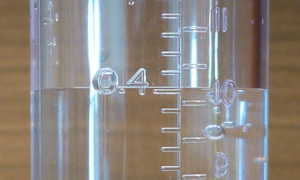
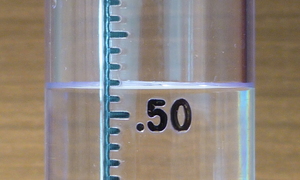


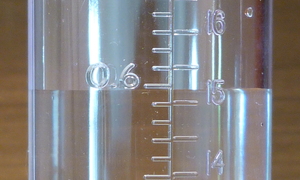
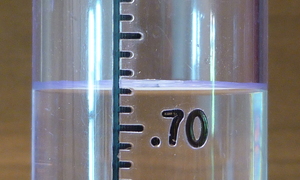
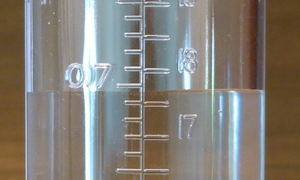
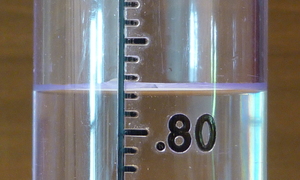
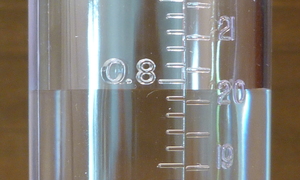

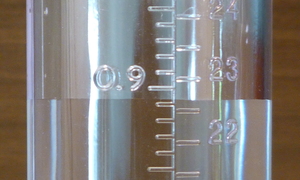

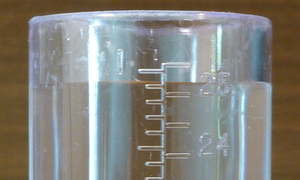
Notes:
Any bias in the above 0.10" steps will be repeated ten times. At
least from the steady error percentage visible with the old PA tube
above, it appears that any bias is very repeatable.
The meniscus on the PA tube looks like it is the bright horizontal line, but
it's actually lower. If you look at the right side of the 0.80 photo,
the bright vertical bar is bent due to refraction, and it ends at the
bottom of the menisicus.
The first couple of photos of the OB tube do not have the camera quite
horizontal, it's slightly looking up at the bottom of the
meniscus.
The thickness of the meniscus on the OB gauge is almost zero. I
don't know if this is a function of age or different plastic
composition.
I'll be painting the raised plastic on the OB tube. The PA tube,
even with the worn paint, is much easier to read.
On the old PA tube, the meniscus goes through the center of the 0.41"
and 0.82" marks. That means the gauge is reading 2.5% high.
On the OB tube, the readings appear a tiny bit high in the 0.3" to
0.4" photos, and low on the rest, but by less than 0.01" throughout. All
appear to represent an error of less than 1%.
When the new gauge arrived, I ran its inner tube through the
procedure above. The true bottom of the meniscus was still difficult to
see, but one intercepted the 0.61" mark, so the new tube appears more
accurate (for the 20.59 gram measurements). I expected that any change
would be to shrink in all dimensions, and that would result in higher
readings.
At this point, it appears the PA gauge reads high, and the while the OB
gauge reads low, it's more accurate. While the claim that the OB gauge reads
low is holding up, the criticism that the OB gauge reads low is not.
System measurements
Ultimately, we need to look at the performance of the full system. It
would be nice to put all the rain gauges outside, trigger a 0.90" to 1.00"
rain storm, and measure. Obviously, that's not an option. Instead, here I
take the amount of water the actual funnel will catch in a 1.00" rain event,
accounting for the density of my room temperature water. The water was added
directly to the inner tube and the cotton swab technique used to get the full
accuracy. This both reduces the measuring bias of making ten samples and
any issues with pouring from the measuring cup to the tube.
Here are photos for each of the three tubes:
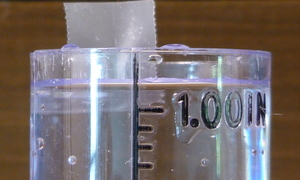
Productive Alternatives (old) |
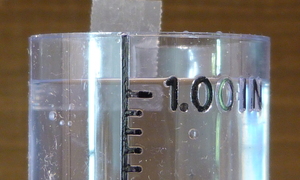
Productive Alternatives (new) |
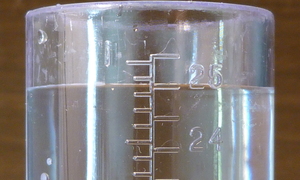
Outback Blue |
In the previous section, the OB tube was more accurate but read low and the
PA tubes read high. Now the relationship is the same, but both the old PA and
the OB tube have a similar error, but with different signs. The new PA tube
is the most accurate.
A convenient rain storm
I installed the OB gauge at the beginning of a rainstorm that looked liked it
would bring about an inch of rain. The storm was well over one inch, so I
measured it following the CoCoRaHS procedure, i.e.:
Transfer out a bit of water from the inner gauge to the outer so that it reads a bit less than 1.00".
Record that, "discard" water in inner tube.
Transfer the remaining water from the outer tube to the inner tube, using the funnel for assistance.
Record that amount (adding it to the first measurement), "discard" water.
Of course, I discarded water into a bowl so I could weigh it.
I wound up with 1.44" (288 grams) from the PA gauge and 1.39" (289 grams)
from the OB gauge. I used my old scale that is quite accurate, but only has
1 gram resolution. From the measured funnel areas, I would expect a
difference of about 0.5% (80.3 :: 80.7). It was nice to see that match.
However, the PA gauge's 1.44" means that a 1" rainfall would take exactly
200 grams. The OB gauge would take 208 grams. This suggested that the OB
gauge was more accurate, and closer to the 205.9 ml calculated above for the
4.00" funnel size I assumed I had.
From the better calculations, a 1" rainfall in the PA gauge should take 203 grams, a 1.5% difference,
and the OB gauge should take 204 grams, a 2% difference. Those errors are a bit more than I'd like to
see, but some of that comes from the 1 gram scale resolution, some comes from inaccuracy (it may read
less than 1% too high), and there are opportunities for measurement error.
Future significant rainfalls will be checked with the 0.01 gram scale.
Conclusions
The main conclusion is that both gauges appear to be about equally accurate,
but the errors have a different sign. The measurements are delicate, and
deserve to be redone, but ultimately the test boils down to what people can
read against a scale with 0.01" resolution.
Apparently the early CoCoRaHS test was for a gauge with a error of ± 4%
in a wide range of weather conditions. The similar design of the two gauges
suggest both will pass, they certainly do in low wind conditions.
My concern that the early criticism of the OB gauge was unfair is confirmed.
The tests above are not a complete comparison, there are several more things that can be investigated, some are included below.
There are various questions and claims that can be addressed.
Claim: "the Outback Blue rain gauge is consistently measuring less
precipitation than the standard CoCoRaHS rain gauge."
The quote is from https://www.cocorahs.org/Media/Docs/CoCoRaHS-OutbackBlue.pdf . The statement
certainly appears to be accurate, however it is misleading and has misled.
A couple years ago I discovered there was a problem with converting between
the weight of rain water the PA gauge catches and depth it represents and
that the PA consistently measures higher than the math suggests. The
CoCoRaHS statement is misleading in that it doesn't mention the possibility
that the Outback Blue gauge is accurate and the PA gauge is not.
This claim has misled people to post 1-star reviews of the Outback Blue on
Amazon.com. At the moment, there are five one-star reviews saying that
CoCoRaHS has rejected the gauge. E.g. "Received official email today
saying do not use this gauge for Cocorahs measurements. They have been
testing this gauge and reads low. The inner scale is not in calibration."
Note how the poster changed the CoCoRaHS claim to drop the reference to the
standard gauge so that it unambiguously says the OB is wrong. Or "Being a
member of CocoRahas [sic] I can tell you this is NOT an accurate rain
gauge...."
Claim: The Outback Blue rain gauge can be used for CoCoRaHS reports.
That was on the product page for the OB gauge, but has since been removed.
It was not on the packaging for the gauge.
It's time to take down or tame the 1-star reviews. Note that there are
people who want a rain gauge and don't want to or cannot report precip data
CoCoRaHS. For example, everyone in Australia. Or people in over 100 other
countries, several where appreciate the English/Metric dual scale might be appreciated.
What is CoCoRaHS's acceptance criteria for rain gauges?
In some references, the PA gauge was selected as the only gauge to use.
Others read as though gauges that have similar characteristics are
acceptable, but the OB gauge is the first one worth considering. Doesken 2005 notes a 10 year study where the PA gauge
consistently reports a larger value than the Standard 8" Rain Gauge. The
difference may be due to the standard gauge wetting its metal surface and
drying instead of funneling the rain into the collection tube. However,
it's an interesting comparison given that the OB gauge is noted to
consistently report less than the PA gauge. That report also notes "Based
on its reputation and its affordable cost, we selected the 4 inch-diameter
gauge as our standard for the Community Collaborative Rain, Hail and Snow
Network (Reges et al., 2005)."
The main criterium seems to recording values within ± 4% of the
Standard Rain Gauge. However, the discussion the OB gauge includes
references to the importance of consistency (precision) and that appears to
be valued more than accuracy, how close a measurement is to it's accepted
value. There is no satisfying solution to that, but in general I prefer
accuracy, at least in future data. The climate record has been criticized by
attempts to "correct" past data and there are many accusations by climate
skeptics that the corrections have erroneously lowered past temperatures
which exacerbates current warming claims. On the other hand, some record
high temperatures in Hawaii were due to equipment failure, but allowed to
stand even after the equipment was fixed.
Accepting a mix of PA data (too high) and OB data (too low) can't be good.
Neither can accepting those data after adjustments, especially if the raw
data is discarded. What should CoCoRaHS do if it expands into another
country? Start its record with data known to be inaccurate? Tell Australians
that they must use the PA gauge and not the OB gauge? CoCoRaHS, welcome to
the controversy. There is no escape.
Can/Should precip measurements be made by weight?
I was first drawn to this as an alternative to measuring snow water
equivalent by weighing instead of melting and the processing with the
rainfall procedure. Even for measuring liquid precipitation, weighing is
faster, especially for rainfall over one inch, and completly avoids the
skill needed to read the meniscus, something I've suspected is more
difficult than most people realize. However, it appears the conversion
factors will need to be selected from computations like mine or from direct
measurements to preserve the "right" error.
The conversion factors must be chosen either to match the reading on the
gauge or to map the reading on to a more accurate amount per the previous
section. Similar considerations could be applied to the OB gauge, with an
appropriate conversion factor to map weight to the OB scale, the PA scale, or
to a most accurate scale. It was so much simpler when the "obvious" thing to
do was use 205.9, the weight of a 4" diameter disk, 1" thick of 1 g/ml water.
Are we done?
Heh. Hardly. I want to look at the weight and thickness of PA and (lighter)
OB gauges, and of my old and new PA gauges. I might want to trade my new
gauge for a gauge that has suffered in Arizona heat and sun and measure that.
I noticed yesterday afternoon that the PA gauge had all the water in the
bottom of the inner tube, but the OB gauge had condensation haze and small
droplets higher in the tube. Their black plastic and funnel opening shape
deserves investigation. Reading the meniscus on the PA gauge is a challenge,
I have some ideas on how to make it more visible.
References
Doesken, N. J., 2005: A ten-year comparison of daily precipitation from the
4" diameter clear plastic rain gauge versus the 8" diameter metal standard
rain gauge. 13th Symp. on Meteorological Observations and Instrumentation,
Savannah, GA, Amer. Meteor. Soc., 2.2. [Available online
at https://ams.confex.com/ams/15AppClimate/techprogram/paper_91615.htm.]
Sevruk, B., and S. Klemm, 1989: Catalogue of national standard
precipitation gauges. Instruments and Observing Methods Rep. 39, WMO
Tech. Doc. WMO/TD-313, 50 pp. [Available online at
http://www.wmo.int/pages/prog/www/IMOP/publications/IOM-39.pdf.]
N.B. This document was written by Eric Werme, Sutton Mills NH. Any errors
that could be mine are mine. CoCoRaHS was not actively involved in the initial writing.
Contact Ric Werme or
return to his home page.
Written 2019 July 28, last updated 2023 March 6.
























